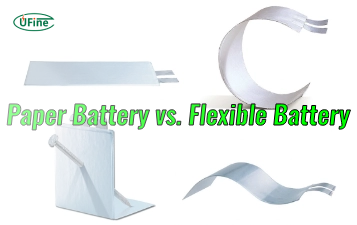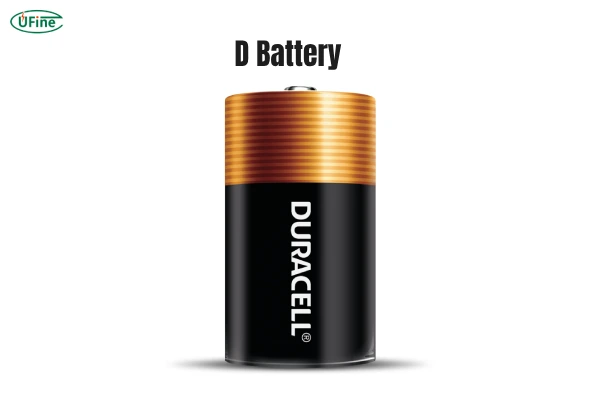Part 1. Understanding the D battery
D battery, also referred to as D cell battery, R20 battery or D cell , is cylindrical in shape and is one of the largest standard battery sizes. Their significant size allows them to store a substantial amount of energy, making them ideal for devices that consume more power or operate continuously for longer periods.
The history of the D battery dates back to the early 20th century, where they were initially developed to provide a reliable energy source for flashlights. Over time, their usage expanded into various industries, becoming a staple in both consumer electronics and industrial tools. The main distinction between a D battery and smaller batteries like AA or AAA is their energy capacity, which is exponentially greater due to the battery’s size and internal construction.
Their working principle involves the conversion of chemical energy into electrical energy. Inside, a D battery houses electrodes and electrolytes, which facilitate an electrochemical reaction to produce a consistent flow of electricity. This ensures your devices keep running smoothly and efficiently.
Part 2. D battery voltage
One of the key factors to consider when choosing a D battery is its voltage and capacity. A standard D battery delivers 1.5 volts.
However, the capacity (measured in milliampere hours, or mAh) varies depending on the battery’s chemical composition.
For instance:
- Alkaline D batteries typically have a capacity of 12,000-18,000 mAh.
- Rechargeable NiMH D batteries offer capacities ranging from 2,000 to 10,000 mAh.
To put this in perspective, a high-capacity D battery can power a flashlight continuously for several hours, or even days, depending on the energy consumption of the device. This is especially beneficial for emergency kits, where reliable power for essential equipment is a necessity.
Lithium VS. Alkaline Batteries: A Comprehensive Comparison
Part 5. Types of D batteries
There are several types of D batteries, each with its own benefits and drawbacks depending on the application:
-
Alkaline D Batteries: These are the most common and widely available. Alkaline D batteries are affordable and offer a reliable energy source for low- to moderate-drain devices. Their longer shelf life makes them a go-to choice for emergency kits.
-
NiMH (Nickel-Metal Hydride) Rechargeable D Batteries: Ideal for devices that require frequent use, rechargeable D batteries can be reused hundreds of times, reducing waste and saving money over the long term. They do, however, have a lower initial capacity compared to alkaline batteries.
-
Lithium D Batteries: These are high-performance batteries that excel in extreme conditions. They last longer than both alkaline and NiMH batteries and are well-suited for temperature-sensitive environments. However, they tend to be more expensive.
-
Carbon-Zinc D Batteries: These are less common today but are used in very low-drain devices. They are generally cheaper, but their performance lags behind that of alkaline and lithium batteries.
Part 4. Size and shape
The size and shape of D batteries make them uniquely suited for larger devices. A standard D battery is 61.5mm in length and has a 34.2mm diameter. This large surface area allows for more active material within the battery, which translates into greater energy capacity.
While some may see the larger size as a disadvantage in terms of portability, it is precisely this design that gives the D battery its power-packed performance. Devices like boom boxes, camping lanterns, and battery-powered tools heavily rely on this capacity for consistent and prolonged use.
Part 3. Weight
The weight of a D battery is another consideration, especially when used in portable devices. Alkaline D batteries weigh approximately 140-150 grams, while rechargeable versions, particularly NiMH D batteries, can be heavier due to their internal components. While this weight may seem excessive, especially compared to lighter battery types, it’s a small trade-off for the extended lifespan and performance they offer.
For example, in devices like emergency radios or portable fans, the heavier weight of the D battery is a reasonable compromise given the reliability and duration of power provided. This is especially important during outdoor activities or in locations where changing batteries frequently is impractical.
Part 6. Pros and cons of D batteries
Let’s break down the pros and cons of using D batteries:
Pros:
- High Capacity: D batteries can store a significant amount of energy, which makes them ideal for high-drain devices.
- Long Lifespan: Alkaline and lithium D batteries can last for long periods in storage, making them perfect for emergency kits or infrequently used devices.
- Versatility: Available in both disposable and rechargeable options, D batteries can suit a wide range of devices and needs.
Cons:
- Size and Weight: The bulk of a D battery makes it less suitable for smaller or portable devices where weight and size are a concern.
- Higher Cost for Rechargeables: While rechargeable D batteries offer long-term savings, the upfront cost is higher compared to disposable versions.
Part 7. Applications
D batteries are commonly used in a wide range of devices, primarily those requiring more substantial, sustained power. Common applications include:
- Portable radios
- Large flashlights
- Battery-powered toys
- Boom boxes
- Medical equipment
- Camping lanterns
- Remote controls for large electronic devices
In high-stakes or emergency situations, having a reliable D battery can make all the difference.
Part 8. Rechargeable D batteries vs non-rechargeable D batteries
Some D batteries are rechargeable, most notably NiMH (Nickel-Metal Hydride) versions. These rechargeable D batteries can be charged and reused hundreds of times, making them an environmentally friendly option. They are perfect for frequently used devices, as you can save money and reduce battery waste over time. However, they do have a lower capacity compared to alkaline D batteries on a single charge, which is something to keep in mind for high-drain devices.
Rechargeable vs. Disposable D Batteries:
- Disposable: Cost-effective for infrequent use but non-rechargeable (e.g., alkaline).
- Rechargeable: Economical and eco-friendly for regular use (e.g., NiMH or lithium).
D batteries are a popular choice for devices that need a reliable power source, particularly in situations where battery replacement is less convenient.
Part 9. How long does a D battery last?
The lifespan of a D battery depends on its type and the device it powers. For example:
- Alkaline D batteries can last up to five to ten years in low-drain devices when stored properly.
- Rechargeable NiMH D batteries offer a shorter runtime per charge, but can be recharged up to 1,000 times, providing long-term savings.
- Lithium D batteries generally offer a longer operational lifespan than alkaline or NiMH versions, especially in extreme conditions.
In most cases, the right D battery can power devices for extended periods, making them invaluable for devices used in critical moments.
Part 10. D cell battery charger: what you need to know
When choosing a D cell battery charger, you’ll want to consider a few key factors:
- Compatibility: Ensure the charger supports the specific chemistry of your rechargeable D batteries (NiMH or Lithium).
- Charging speed: Faster isn’t always better—sometimes slower charging prolongs battery life.
- Safety features: Look for chargers with overcharge protection, automatic shutoff, and temperature control to protect your batteries.
Investing in a good charger will ensure that your rechargeable D batteries last longer and perform optimally.
D batteries, whether disposable or rechargeable, are the powerhouse behind many essential devices. From flashlights to radios, they provide reliable, long-lasting energy. Understanding the types, capacities, and applications of D batteries allows you to choose the right one for your needs. Whether you’re powering a device for an emergency situation or for daily use, selecting the right D battery will ensure you have the power you need when you need it most.
Related Tags:
More Articles

Paper Battery vs. Flexible Battery: What’s the Difference and Which Is Better?
Paper vs. flexible batteries: learn the key differences, benefits, and which power source fits best for wearables, sensors, and smart tech.
What to Know Before Buying a Tiny LiPo Battery for Your Project
Tiny LiPo batteries are powerful and compact. Learn how to choose the right one for your project with specs, safety, and charging tips.
Bloated LiPo Battery: Will It Explode?
Will a bloated LiPo battery explode? Discover the causes, risks, safety steps, and expert tips to avoid disaster and protect your gear. Must-read safety guide!
12V 100Ah Lithium Ion Battery Price: Full Guide
Learn about 12V 100Ah lithium-ion battery price, from cost ranges to best brands, hidden fees, and how to get the best deal. A must-read for smart buyers!
Resistance and Conductivity: What It Means for Your Lithium Batteries
Resistance and conductivity impact lithium battery performance, lifespan, and safety—learn how they work and why they matter.




